|
MORRISTOWN National Historic Park |
 |
Guide to the Area (continued)
NO. 15. BETTIN OAK AND FORT HILL. Immediately southwest of the campsite occupied by the 2d Maryland Brigade in 1779—80 (No. 14), on the same side of the Jockey Hollow Road, stands the Bettin Oak. Near the base of this old tree is the traditional grave of Capt. Adam Bettin, who was killed on New Year's Night 1781, during the mutiny of the Pennsylvania Line, then encamped nearby under command of Brig. Gen. Anthony Wayne (pp. 27—28). Defensive works for the protection of Wayne's camp were erected on Fort Hill, which rises to the eastward of this point. Nothing is left of these fortifications today.
NO. 16. NEW JERSEY BRIGADE CAMP, 1781—82. About 1,200 feet southwest of the point where the Tempe Wick and Jockey Hollow Roads meet is the traditional campsite occupied in 1781—82 by the New Jersey Brigade under Brig. Gen. Elias Dayton (p. 29). In this brigade at that time were the 1st and 2d New Jersey Regiments, with a combined total enlistment, in April 1782, of around 700 men. The official uniform of these troops was blue, faced with buff; the buttons and linings, white.
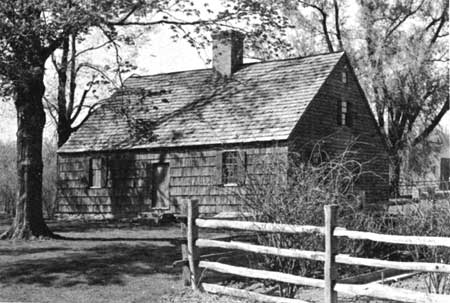
The Wick House, built about 1750, and occupied as quarters by
Maj. Gen. Arthur St. Clair in the winter of 1779—80.
NO. 17. WICK HOUSE, ST. CLAIR'S QUARTERS, 1779—80. On the north side of the Tempe Wick Road, about 325 feet west of its intersection with the Jockey Hollow Road, is the Wick House, which served in 1779—80 as quarters for Maj. Gen. Arthur St. Clair, then commander of the Pennsylvania Line encamped in Jockey Hollow (Nos. 20—21). The building was erected about 1750 by Henry Wick, a fairly prosperous farmer who had come to Morris County from Long Island a few years before. Tempe Wick, his youngest daughter, is said to have concealed her riding horse in a bedroom of the house, in January 1781, in order to prevent its seizure by the Pennsylvania mutineers (pp. 27—28). The interior of the building was furnished with period pieces following its restoration by the National Park Service in 1935. Efforts have also been made to recreate, as far as possible, the colonial atmosphere of the farm itself, as reflected in the nearby garden, barnyard, orchard, and open fields.
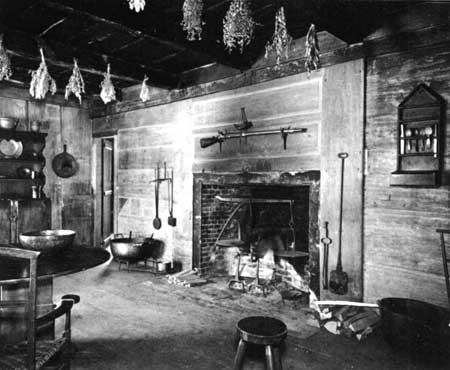
A corner of the kitchen in the Wick House.
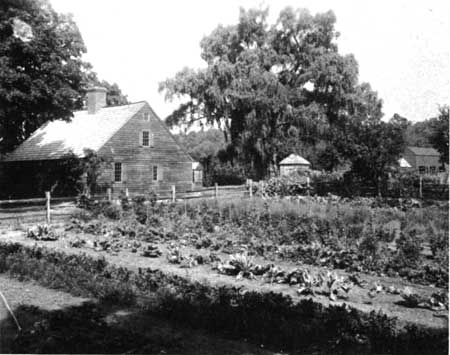
The Wick House garden.
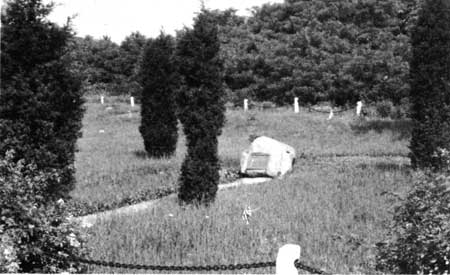
Army Burying Ground in Jockey Hollow.
NO. 18. ARMY BURYING GROUND, 1779—80. On the south side of the Cemetery-Wick House Road, at the point where it joins the Grand Parade Road, is the traditional site of the Continental Army Burying Ground in Jockey Hollow. Here are said to lie the remains of between 100 and 150 American soldiers who failed to survive the terrible winter of 1779—80.
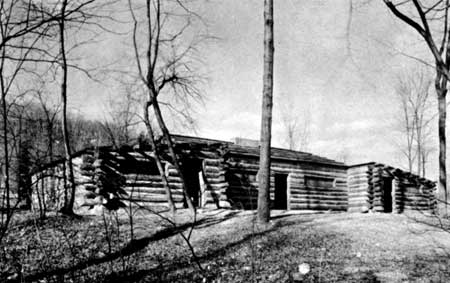
Reconstructed Army Hospital Hut.
NO. 19. RECONSTRUCTED ARMY HOSPITAL HUT, 1779—80. Immediately adjacent to the Army Burying Ground (No. 18), visitors may see a log structure of the type used for hospital purposes while the Continental Army lay encamped in Jockey Hollow. This building was reconstructed by the National Park Service from a description and plans prepared by Dr. James Tilton, Hospital Physician in 1779—80, and later Physician and Surgeon General, United States Army.
NOS. 20—21. FIRST AND SECOND PENNSYLVANIA BRIGADE CAMPS, 1779—80 AND RECONSTRUCTED OFFICERS' HUT. About 400 feet east of the reconstructed Army Hospital Hut (No. 19), on the west slope of Sugar Loaf Hill, and cutting diagonally across the Grand Parade Road, are the campsites occupied in 1779—80 by the Pennsylvania Division commanded that winter by Maj. Gen. Arthur St. Clair. In this division were the 1st and 2d Pennsylvania Brigades. The former, under Brig. Gen. William Irvine, was composed of the 1st, 2d, 7th, and 10th Pennsylvania Regiments, with a combined total enlistment, in December 1779, of 1,253 men. In the latter, under Col. Francis Johnston, were the 3d, 5th, 6th, and 9th Pennsylvania Regiments, with a corresponding enlistment, at the same period, of 1,050 men. The official uniform of all these troops was blue, faced with red; the buttons and linings, white.
On the First Pennsylvania Brigade campsite may be seen a reconstruction, by. the National Park Service, of the type of log hut used as quarters by officers of the Continental Army in 1779-80 (p. 16).
NO. 22. GRAND PARADE, 1779—80. North of the Grand Parade Road, below the east slope of Sugar Loaf Hill, is the level ground "between the Pensylvania & the York encampment" which served as the Grand Parade used by the Continental Army in 1779—80. Here the camp guards and detachments assigned to outpost duty usually reported for inspection, and the troops were sometimes paraded to witness military executions. The ground was also used for drill purposes. Near the Grand Parade was the "New Orderly Room" where courts martial were frequently held, and where Washington's orders were communicated to the army.
NO. 23. HAND'S BRIGADE CAMP, 1779—80, AND RECONSTRUCTED SOLDIERS' HUT. Parallel to the north side of the Tempe Wick Road, about 300 feet southeast of where it joins the Jockey Hollow Road, is the campsite occupied in 1779—80 by Hand's Brigade, named for its commanding officer, Brig. Gen. Edward Hand. In this brigade were the 1st and 2d Canadian and the 4th and New 11th Pennsylvania Regiments, with a combined total enlistment, in December 1779, of 1,033 men. The official uniform of the Pennsylvania regiments was blue, faced with red; the buttons and linings, white. How all the Canadians were clothed is unknown, but some of them probably wore brown coats, faced with red, and white waistcoats and breeches.
This identical campsite was occupied by part of the Pennsylvania Line early in the winter of 1780—81, and from about February 7 to July 8, 1781, by the New Jersey Brigade of the Continental Army. Here occurred the great mutiny of the Pennsylvanians on New Year's Night 1781 (pp. 27—28).
On the Hand's Brigade campsite may be seen a reconstruction, by the National Park Service, of the type of log hut used by private soldiers of the Continental Army in 1779—80 (p. 16).
NOS. 24—25. FIRST AND SECOND CONNECTICUT BRIGADE CAMPS, 1779—80. About 600 feet northeast of the Tempe Wick Road, along the south and east slopes of Fort Hill (No. 15), are the campsites occupied early in 1779—80 by the 1st and 2d Connecticut Brigades. The former, under Brig. Gen. Samuel Holden Parsons, was composed of the 3d, 4th, 6th, and 8th Connecticut Regiments, with a combined total enlistment, in December 1779, of 1,680 men. In the latter, under Brig. Gen. Jedediah Huntington, were the 1st, 2d, 5th, and 7th Connecticut Regiments, with a corresponding enlistment, at the same period, of 1,367 men. The official uniform of all these troops was blue, faced with white; the buttons and linings, white.
Both brigades left camp for detached duty "on the Lines" at Springfield and Westfield early in February 1780. On returning to camp, about the middle of May, they occupied the log huts vacated by the Maryland troops on April 17 preceding (Nos. 13—14). It was there that the 4th and 8th Connecticut Regiments rose in mutiny soon afterward (p. 18).
Some of the log huts built by the 1st Connecticut Brigade were occupied by Pennsylvania troops early in the following winter, previous to the mutiny which broke out on New Year's Day 1781 (pp. 27—28).
NO. 26. SITE OF KEMBLE HOUSE, WAYNE'S QUARTERS, 1780—81. At the northwest corner of Mount Kemble Avenue (U. S. Route 202) and the Tempe Wick Road is the site of Kemble Manor, built about 1765 as a residence for the Honorable Peter Kemble, one of the wealthiest and most influential men in the late colonial period of New Jersey history. Here were the quarters of Brig. Gen. William Smallwood, of the Maryland Line, in 1779—80; and of Brig. Gen. Anthony Wayne, of the Pennsylvania Line, in 1780—81. From "Mount Kemble," early on the morning of January 2, 1781, Wayne wrote a hurried letter to Washington describing the Pennsylvania Mutiny, which had taken place but a few hours before (pp. 27—28). In the nineteenth century the Kemble House was moved some distance north of its original location. It no longer bears much resemblance to the structure of Revolutionary War times.
NO. 27. STARK'S BRIGADE CAMP, 1779—80. Along the east slope of Mount Kemble, on the west side of Mount Kemble Avenue (U. S. Route 202), about five-sixths of a mile northwest of its intersection with the Tempe Wick Road, is the campsite occupied in 1779—80 by Stark's Brigade, named for its commanding officer, Brig. Gen. John Stark. In this brigade were Webb's and Sherburne's Connecticut Regiments, Jackson's Massachusetts Regiment, and the 2d Rhode Island Regiment, with a combined total enlistment, in December 1779, of 1,210 men. This site is privately owned and not accessible to park visitors. The official uniform of both the Connecticut and Rhode Island troops was blue, faced with white; the buttons and linings, white.
NO. 28. KNOX ARTILLERY CAMP, 1779—80. One mile west of Morristown, along the main road to Mendham (New Jersey Route 24), and at the base of a hill opposite the further end of Burnham Park, is the site occupied in 1779—80 by the Light Artillery Park and the Artillery Brigade of the Continental Army under Brig. Gen. Henry Knox. In this brigade were the 1st, 2d, 3d, and 4th Artillery Regiments. Knox's quarters were nearby on what is now Kahdena Road, at a place called "Duchman's." The official artillery uniform was "Blue faced with Scarlet, Scarlet Lining, Yellow buttons, Yellow bound hats, Coats edged with narrow lace or tape and button holes bound with the same."

|
|
Last Modified: Mon, Dec 2 2002 10:00:00 am PDT |


